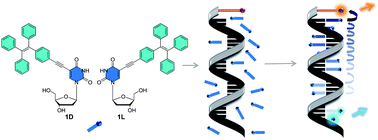DNA-templated control of chirality and efficient energy transport in supramolecular DNA architectures with aggregation-induced emission†
Abstract
Two conjugates of tetraphenylethylene with D-2′-deoxyuridine (1D) and L-2′-deoxyuridine (1L) were synthesized to construct new supramolecular DNA-architectures by self-assembly. The non-templated assemblies of 1D and 1L show strong aggregation-induced emission and their chirality is exclusively controlled by the configuration of their sugar part. In contrast, the chirality of the DNA-templated assemblies is governed by the configuration of the DNA, and there is no configuration-selective binding of 1D to D-A20 and 1L to L-A20. The quantum yield of the assembly of 1D along the single-stranded DNA A20 is 0.40; approximately every second available binding site on the DNA template is occupied by 1D. The strong aggregation-induced emission of these DNA architectures can be efficiently quenched and the excitation energy can be transported to Atto dyes at the 5′-terminus. A multistep energy transport “hopping” precedes the final energy transfer to the terminal acceptor. The building block 1D promotes this energy transport as stepping stones. This was elucidated by reference DNA double strands in which 1D was covalently incorporated at two distinct sites in the sequences, one near the Atto dye, and one farther away. This new type of completely self-assembled supramolecular DNA architecture is hierarchically ordered and the DNA template controls not only the binding but also the energy transport properties. The high intensity of the aggregation-induced emission and the excellent energy transport properties make these DNA-based materials promising candidates for optoelectronic applications.



 Please wait while we load your content...
Please wait while we load your content...